Business Environment Project: Macro & Micro Analysis
VerifiedAdded on 2020/07/23
|10
|2863
|85
Project
AI Summary
This project analyzes the business environment, focusing on macro and micro factors that influence business operations and decision-making. It begins with an introduction to the business environment and its impact, followed by an examination of positive and negative impacts of the macro environment. The project then applies the PESTLE model to analyze external factors affecting a firm. Further, the project delves into internal and external business analysis, exploring strengths, weaknesses, opportunities, and threats (SWOT) and their interlinkage with external macro factors. A detailed SWOT analysis is presented, highlighting its impact on the decision-making process. The project concludes with a discussion on the implications of both macro and micro factors on business decision-making, providing a comprehensive overview of the business environment and its strategic implications.

BUSINESS
ENVIRONMENT
(Project 2)
ENVIRONMENT
(Project 2)
Paraphrase This Document
Need a fresh take? Get an instant paraphrase of this document with our AI Paraphraser
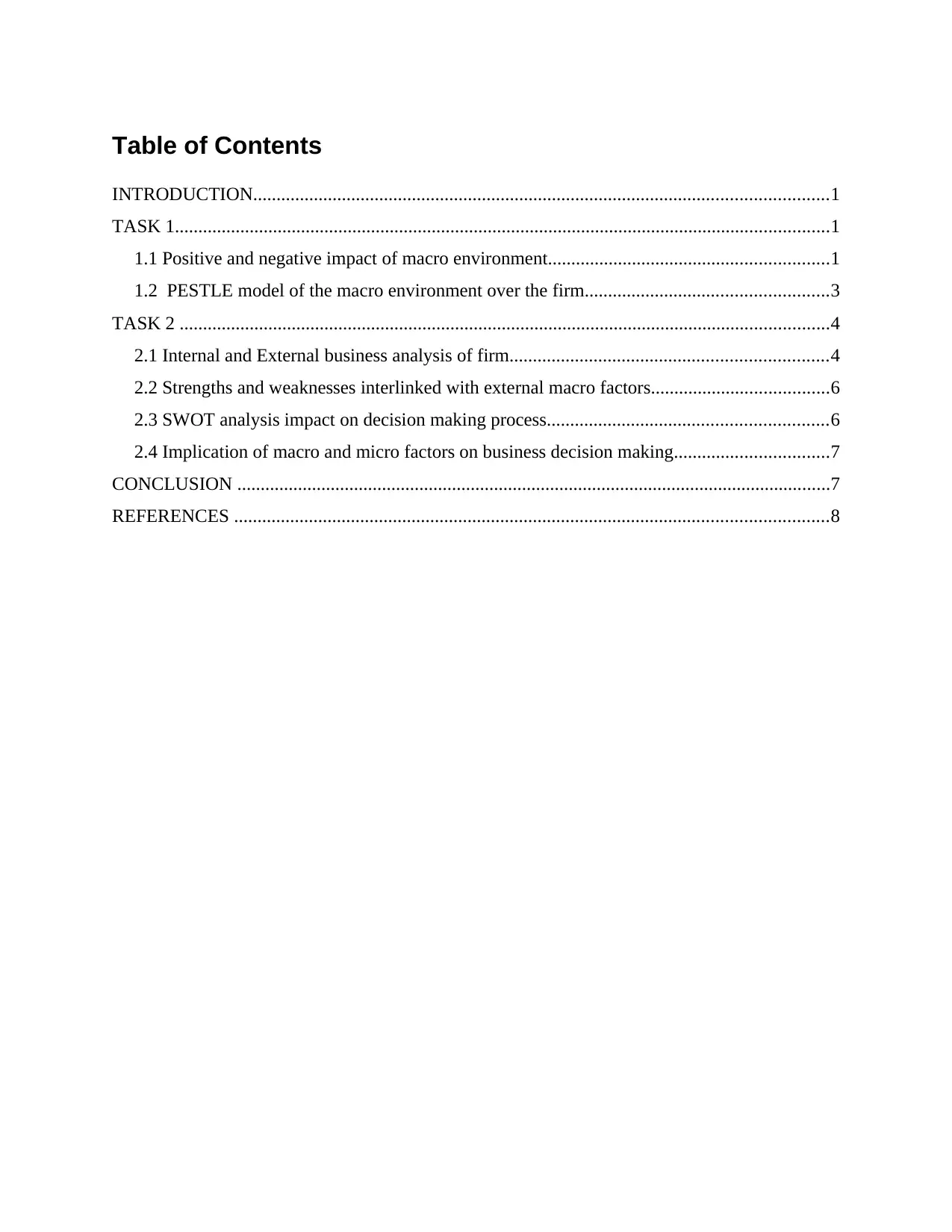
Table of Contents
INTRODUCTION...........................................................................................................................1
TASK 1............................................................................................................................................1
1.1 Positive and negative impact of macro environment............................................................1
1.2 PESTLE model of the macro environment over the firm....................................................3
TASK 2 ...........................................................................................................................................4
2.1 Internal and External business analysis of firm....................................................................4
2.2 Strengths and weaknesses interlinked with external macro factors......................................6
2.3 SWOT analysis impact on decision making process............................................................6
2.4 Implication of macro and micro factors on business decision making.................................7
CONCLUSION ...............................................................................................................................7
REFERENCES ...............................................................................................................................8
INTRODUCTION...........................................................................................................................1
TASK 1............................................................................................................................................1
1.1 Positive and negative impact of macro environment............................................................1
1.2 PESTLE model of the macro environment over the firm....................................................3
TASK 2 ...........................................................................................................................................4
2.1 Internal and External business analysis of firm....................................................................4
2.2 Strengths and weaknesses interlinked with external macro factors......................................6
2.3 SWOT analysis impact on decision making process............................................................6
2.4 Implication of macro and micro factors on business decision making.................................7
CONCLUSION ...............................................................................................................................7
REFERENCES ...............................................................................................................................8

INTRODUCTION
Business environment compose of various factors which are directly affecting
performance of business organisations. The environment is composed of two different factors
such and internal and external which are greatly affecting operations of business. The internal
factors compose of employees, management and external factors compose of customers,
stakeholders, suppliers etc. the report contains the study about impact of business in negative and
positive ways, the use of PESTEL analysis in order to resolve all type of difficulties which are
faced by business. Internal and external business analysis are helpful in order to analyse all
strong and weak points of business.
TASK 1
1.1 Positive and negative impact of macro environment
In modern business environment there are different factors which are affecting positions
of firms at market places in effective ways. There are different macro environmental factors
which are greatly affecting growth and productivity factors of business. This can be achieved
with the help of conducting PESTEAL analysis in order to find out all the factors which may
affect business activities (Baraya, Budden and Escobar, 2011). These factors are having both
positive and negative impact on various business operations.
The Positive and negative impact of business environment is described below as:
Type Positive impact Negative impact
Political factors These factors consist of various trade
policies, rules and regulations which are
imposed by government. If government
make plans in order to minimise tax
rates on retail products then it will be
advantageous for TESCO as they can
easily expand there business operations
at national and international areas.
Government authorities are in favour of
globalisation thus they are investing
money for development of retail sector.
These factors are uncontrollable
as there are instability in plans
and policies which are executed
by government. Thus it greatly
affects growth and productivity
of business and they are not able
to achieve success in their
operations. Brexit is greatly
affecting GDP and sales ratios of
firms.
1
Business environment compose of various factors which are directly affecting
performance of business organisations. The environment is composed of two different factors
such and internal and external which are greatly affecting operations of business. The internal
factors compose of employees, management and external factors compose of customers,
stakeholders, suppliers etc. the report contains the study about impact of business in negative and
positive ways, the use of PESTEL analysis in order to resolve all type of difficulties which are
faced by business. Internal and external business analysis are helpful in order to analyse all
strong and weak points of business.
TASK 1
1.1 Positive and negative impact of macro environment
In modern business environment there are different factors which are affecting positions
of firms at market places in effective ways. There are different macro environmental factors
which are greatly affecting growth and productivity factors of business. This can be achieved
with the help of conducting PESTEAL analysis in order to find out all the factors which may
affect business activities (Baraya, Budden and Escobar, 2011). These factors are having both
positive and negative impact on various business operations.
The Positive and negative impact of business environment is described below as:
Type Positive impact Negative impact
Political factors These factors consist of various trade
policies, rules and regulations which are
imposed by government. If government
make plans in order to minimise tax
rates on retail products then it will be
advantageous for TESCO as they can
easily expand there business operations
at national and international areas.
Government authorities are in favour of
globalisation thus they are investing
money for development of retail sector.
These factors are uncontrollable
as there are instability in plans
and policies which are executed
by government. Thus it greatly
affects growth and productivity
of business and they are not able
to achieve success in their
operations. Brexit is greatly
affecting GDP and sales ratios of
firms.
1
⊘ This is a preview!⊘
Do you want full access?
Subscribe today to unlock all pages.

Trusted by 1+ million students worldwide
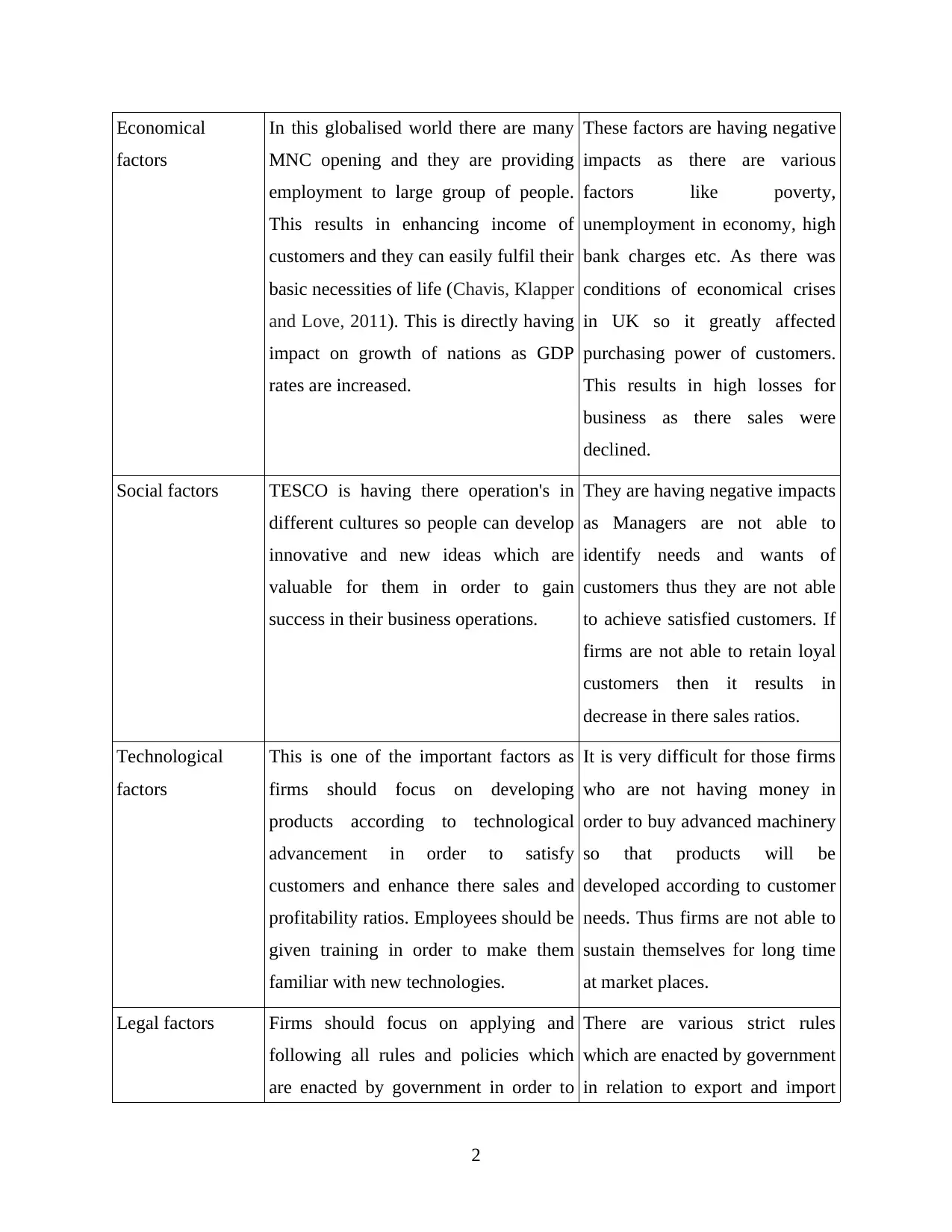
Economical
factors
In this globalised world there are many
MNC opening and they are providing
employment to large group of people.
This results in enhancing income of
customers and they can easily fulfil their
basic necessities of life (Chavis, Klapper
and Love, 2011). This is directly having
impact on growth of nations as GDP
rates are increased.
These factors are having negative
impacts as there are various
factors like poverty,
unemployment in economy, high
bank charges etc. As there was
conditions of economical crises
in UK so it greatly affected
purchasing power of customers.
This results in high losses for
business as there sales were
declined.
Social factors TESCO is having there operation's in
different cultures so people can develop
innovative and new ideas which are
valuable for them in order to gain
success in their business operations.
They are having negative impacts
as Managers are not able to
identify needs and wants of
customers thus they are not able
to achieve satisfied customers. If
firms are not able to retain loyal
customers then it results in
decrease in there sales ratios.
Technological
factors
This is one of the important factors as
firms should focus on developing
products according to technological
advancement in order to satisfy
customers and enhance there sales and
profitability ratios. Employees should be
given training in order to make them
familiar with new technologies.
It is very difficult for those firms
who are not having money in
order to buy advanced machinery
so that products will be
developed according to customer
needs. Thus firms are not able to
sustain themselves for long time
at market places.
Legal factors Firms should focus on applying and
following all rules and policies which
are enacted by government in order to
There are various strict rules
which are enacted by government
in relation to export and import
2
factors
In this globalised world there are many
MNC opening and they are providing
employment to large group of people.
This results in enhancing income of
customers and they can easily fulfil their
basic necessities of life (Chavis, Klapper
and Love, 2011). This is directly having
impact on growth of nations as GDP
rates are increased.
These factors are having negative
impacts as there are various
factors like poverty,
unemployment in economy, high
bank charges etc. As there was
conditions of economical crises
in UK so it greatly affected
purchasing power of customers.
This results in high losses for
business as there sales were
declined.
Social factors TESCO is having there operation's in
different cultures so people can develop
innovative and new ideas which are
valuable for them in order to gain
success in their business operations.
They are having negative impacts
as Managers are not able to
identify needs and wants of
customers thus they are not able
to achieve satisfied customers. If
firms are not able to retain loyal
customers then it results in
decrease in there sales ratios.
Technological
factors
This is one of the important factors as
firms should focus on developing
products according to technological
advancement in order to satisfy
customers and enhance there sales and
profitability ratios. Employees should be
given training in order to make them
familiar with new technologies.
It is very difficult for those firms
who are not having money in
order to buy advanced machinery
so that products will be
developed according to customer
needs. Thus firms are not able to
sustain themselves for long time
at market places.
Legal factors Firms should focus on applying and
following all rules and policies which
are enacted by government in order to
There are various strict rules
which are enacted by government
in relation to export and import
2
Paraphrase This Document
Need a fresh take? Get an instant paraphrase of this document with our AI Paraphraser
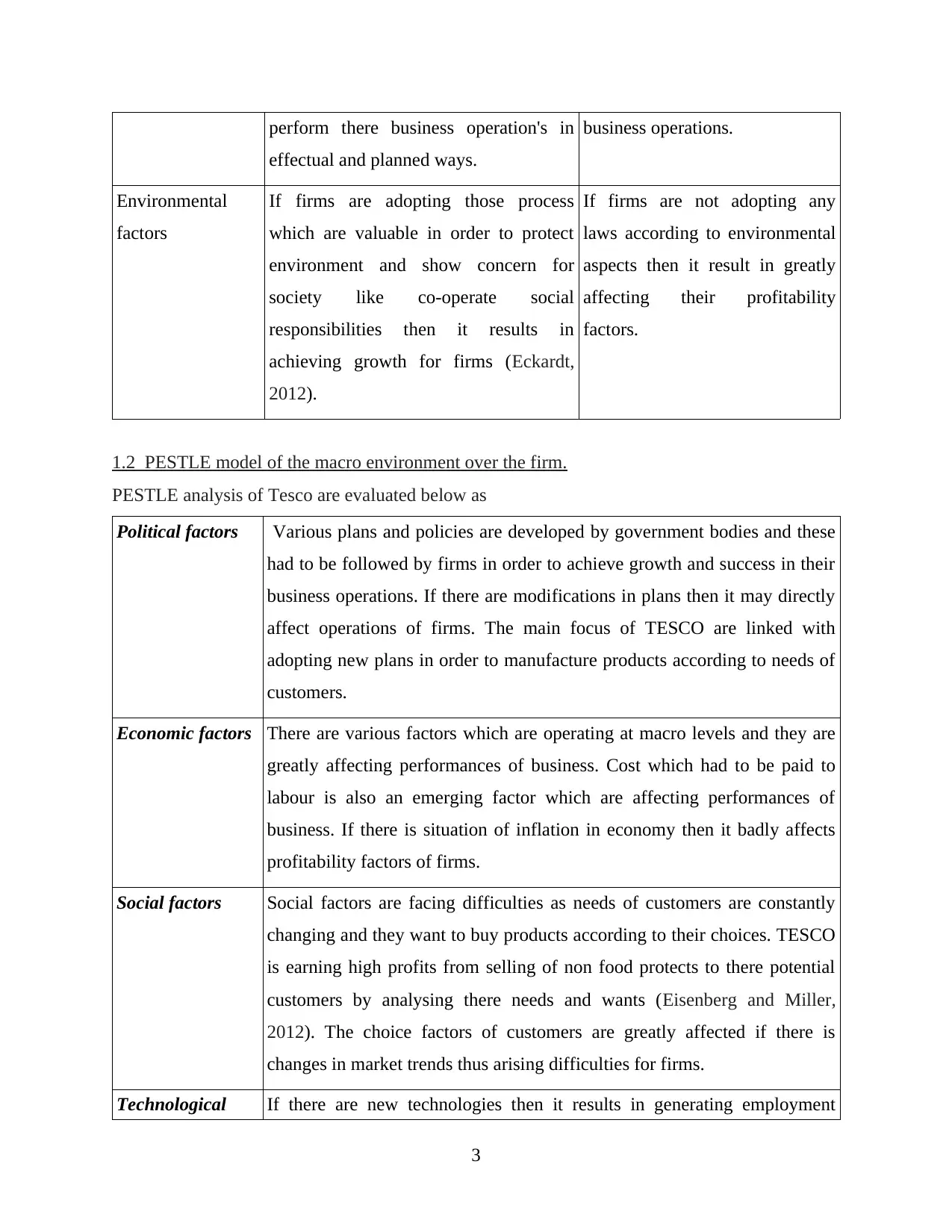
perform there business operation's in
effectual and planned ways.
business operations.
Environmental
factors
If firms are adopting those process
which are valuable in order to protect
environment and show concern for
society like co-operate social
responsibilities then it results in
achieving growth for firms (Eckardt,
2012).
If firms are not adopting any
laws according to environmental
aspects then it result in greatly
affecting their profitability
factors.
1.2 PESTLE model of the macro environment over the firm.
PESTLE analysis of Tesco are evaluated below as
Political factors Various plans and policies are developed by government bodies and these
had to be followed by firms in order to achieve growth and success in their
business operations. If there are modifications in plans then it may directly
affect operations of firms. The main focus of TESCO are linked with
adopting new plans in order to manufacture products according to needs of
customers.
Economic factors There are various factors which are operating at macro levels and they are
greatly affecting performances of business. Cost which had to be paid to
labour is also an emerging factor which are affecting performances of
business. If there is situation of inflation in economy then it badly affects
profitability factors of firms.
Social factors Social factors are facing difficulties as needs of customers are constantly
changing and they want to buy products according to their choices. TESCO
is earning high profits from selling of non food protects to there potential
customers by analysing there needs and wants (Eisenberg and Miller,
2012). The choice factors of customers are greatly affected if there is
changes in market trends thus arising difficulties for firms.
Technological If there are new technologies then it results in generating employment
3
effectual and planned ways.
business operations.
Environmental
factors
If firms are adopting those process
which are valuable in order to protect
environment and show concern for
society like co-operate social
responsibilities then it results in
achieving growth for firms (Eckardt,
2012).
If firms are not adopting any
laws according to environmental
aspects then it result in greatly
affecting their profitability
factors.
1.2 PESTLE model of the macro environment over the firm.
PESTLE analysis of Tesco are evaluated below as
Political factors Various plans and policies are developed by government bodies and these
had to be followed by firms in order to achieve growth and success in their
business operations. If there are modifications in plans then it may directly
affect operations of firms. The main focus of TESCO are linked with
adopting new plans in order to manufacture products according to needs of
customers.
Economic factors There are various factors which are operating at macro levels and they are
greatly affecting performances of business. Cost which had to be paid to
labour is also an emerging factor which are affecting performances of
business. If there is situation of inflation in economy then it badly affects
profitability factors of firms.
Social factors Social factors are facing difficulties as needs of customers are constantly
changing and they want to buy products according to their choices. TESCO
is earning high profits from selling of non food protects to there potential
customers by analysing there needs and wants (Eisenberg and Miller,
2012). The choice factors of customers are greatly affected if there is
changes in market trends thus arising difficulties for firms.
Technological If there are new technologies then it results in generating employment
3

factor opportunities to large group of people so they can fulfil basic necessities of
their life. TESCO have expanded there operations in online so that
customers can easily purchase there goods. They have made plans in order
to invest money in energy saving projects in order to make reduction in
carbon footprints.
Environmental
factor:
The main concern of business are linked with making reduction in carbon
footprints so there environmental conditions can be easily improved. Plans
are executed in order to minimize wastage thus developing social
responsibilities for people.
Legal factor The plans and policies which are developed by government are greatly
affecting performance factors of business so they are not able to achieve
success in their operations. There are various codes of practices developed
in order to analyse changes in needs and demands of customers.
TASK 2
2.1 Internal and External business analysis of firm
The main focus areas of firms are linked with development of plans in order to easily
satisfy needs and wants of all their customers in order to enhance there profitability ratios.
SWOT analysis are important tools in order to evaluate performance of business at market places
(George and Bock, 2011). Internal factors compose of strong and weak points and external
factors includes opportunities and threats which are described under as:
Internal and External business environment
Strength There strong point is linked with they are having large group of
customers who are using there services and they have expanded
there business operations at national and international areas. Various
strategies are developed by TESCO which are useful for them in
order to increase productivity ratios developing skills of employees.
Thus it is beneficial for firms in order to enhance there sale and
4
their life. TESCO have expanded there operations in online so that
customers can easily purchase there goods. They have made plans in order
to invest money in energy saving projects in order to make reduction in
carbon footprints.
Environmental
factor:
The main concern of business are linked with making reduction in carbon
footprints so there environmental conditions can be easily improved. Plans
are executed in order to minimize wastage thus developing social
responsibilities for people.
Legal factor The plans and policies which are developed by government are greatly
affecting performance factors of business so they are not able to achieve
success in their operations. There are various codes of practices developed
in order to analyse changes in needs and demands of customers.
TASK 2
2.1 Internal and External business analysis of firm
The main focus areas of firms are linked with development of plans in order to easily
satisfy needs and wants of all their customers in order to enhance there profitability ratios.
SWOT analysis are important tools in order to evaluate performance of business at market places
(George and Bock, 2011). Internal factors compose of strong and weak points and external
factors includes opportunities and threats which are described under as:
Internal and External business environment
Strength There strong point is linked with they are having large group of
customers who are using there services and they have expanded
there business operations at national and international areas. Various
strategies are developed by TESCO which are useful for them in
order to increase productivity ratios developing skills of employees.
Thus it is beneficial for firms in order to enhance there sale and
4
⊘ This is a preview!⊘
Do you want full access?
Subscribe today to unlock all pages.

Trusted by 1+ million students worldwide
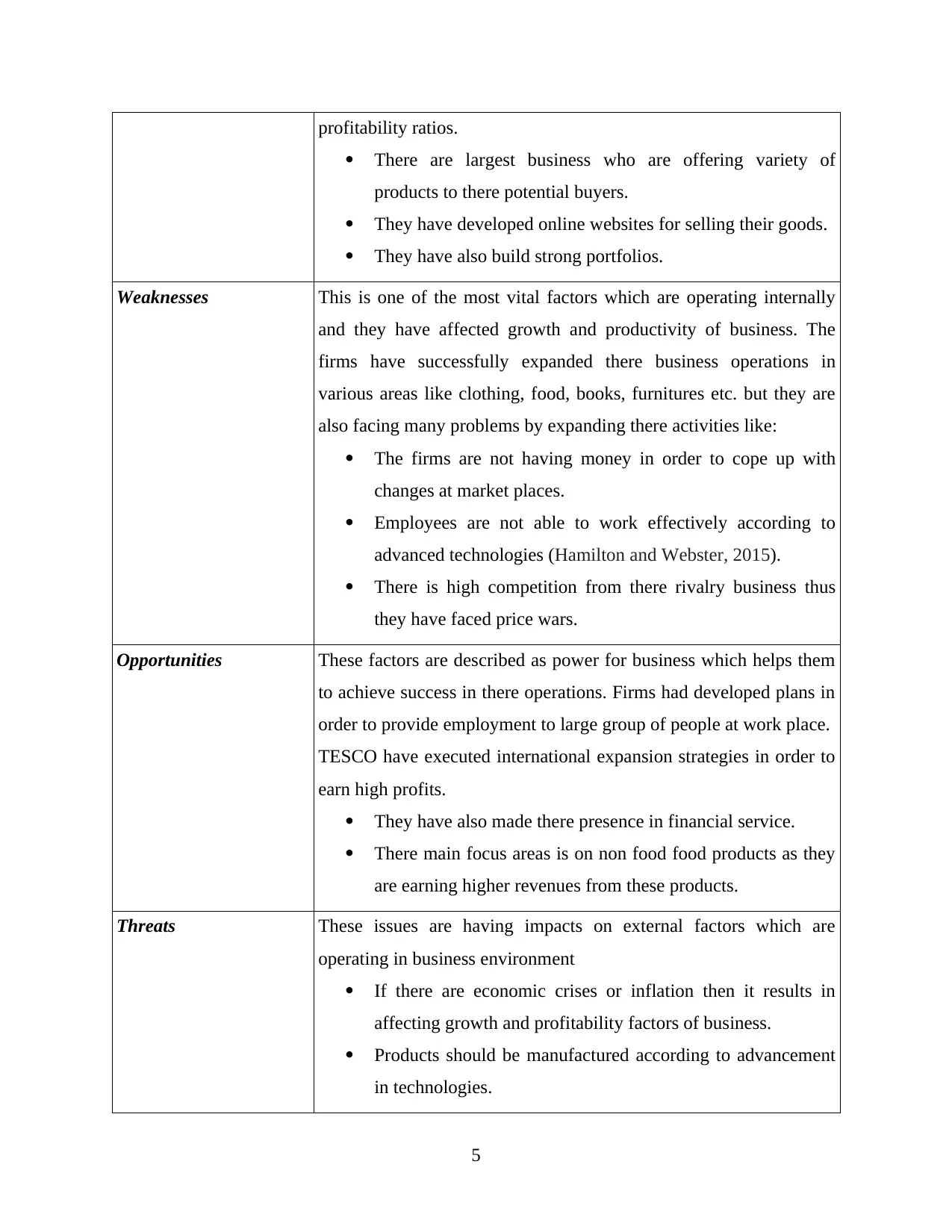
profitability ratios.
There are largest business who are offering variety of
products to there potential buyers.
They have developed online websites for selling their goods.
They have also build strong portfolios.
Weaknesses This is one of the most vital factors which are operating internally
and they have affected growth and productivity of business. The
firms have successfully expanded there business operations in
various areas like clothing, food, books, furnitures etc. but they are
also facing many problems by expanding there activities like:
The firms are not having money in order to cope up with
changes at market places.
Employees are not able to work effectively according to
advanced technologies (Hamilton and Webster, 2015).
There is high competition from there rivalry business thus
they have faced price wars.
Opportunities These factors are described as power for business which helps them
to achieve success in there operations. Firms had developed plans in
order to provide employment to large group of people at work place.
TESCO have executed international expansion strategies in order to
earn high profits.
They have also made there presence in financial service.
There main focus areas is on non food food products as they
are earning higher revenues from these products.
Threats These issues are having impacts on external factors which are
operating in business environment
If there are economic crises or inflation then it results in
affecting growth and profitability factors of business.
Products should be manufactured according to advancement
in technologies.
5
There are largest business who are offering variety of
products to there potential buyers.
They have developed online websites for selling their goods.
They have also build strong portfolios.
Weaknesses This is one of the most vital factors which are operating internally
and they have affected growth and productivity of business. The
firms have successfully expanded there business operations in
various areas like clothing, food, books, furnitures etc. but they are
also facing many problems by expanding there activities like:
The firms are not having money in order to cope up with
changes at market places.
Employees are not able to work effectively according to
advanced technologies (Hamilton and Webster, 2015).
There is high competition from there rivalry business thus
they have faced price wars.
Opportunities These factors are described as power for business which helps them
to achieve success in there operations. Firms had developed plans in
order to provide employment to large group of people at work place.
TESCO have executed international expansion strategies in order to
earn high profits.
They have also made there presence in financial service.
There main focus areas is on non food food products as they
are earning higher revenues from these products.
Threats These issues are having impacts on external factors which are
operating in business environment
If there are economic crises or inflation then it results in
affecting growth and profitability factors of business.
Products should be manufactured according to advancement
in technologies.
5
Paraphrase This Document
Need a fresh take? Get an instant paraphrase of this document with our AI Paraphraser
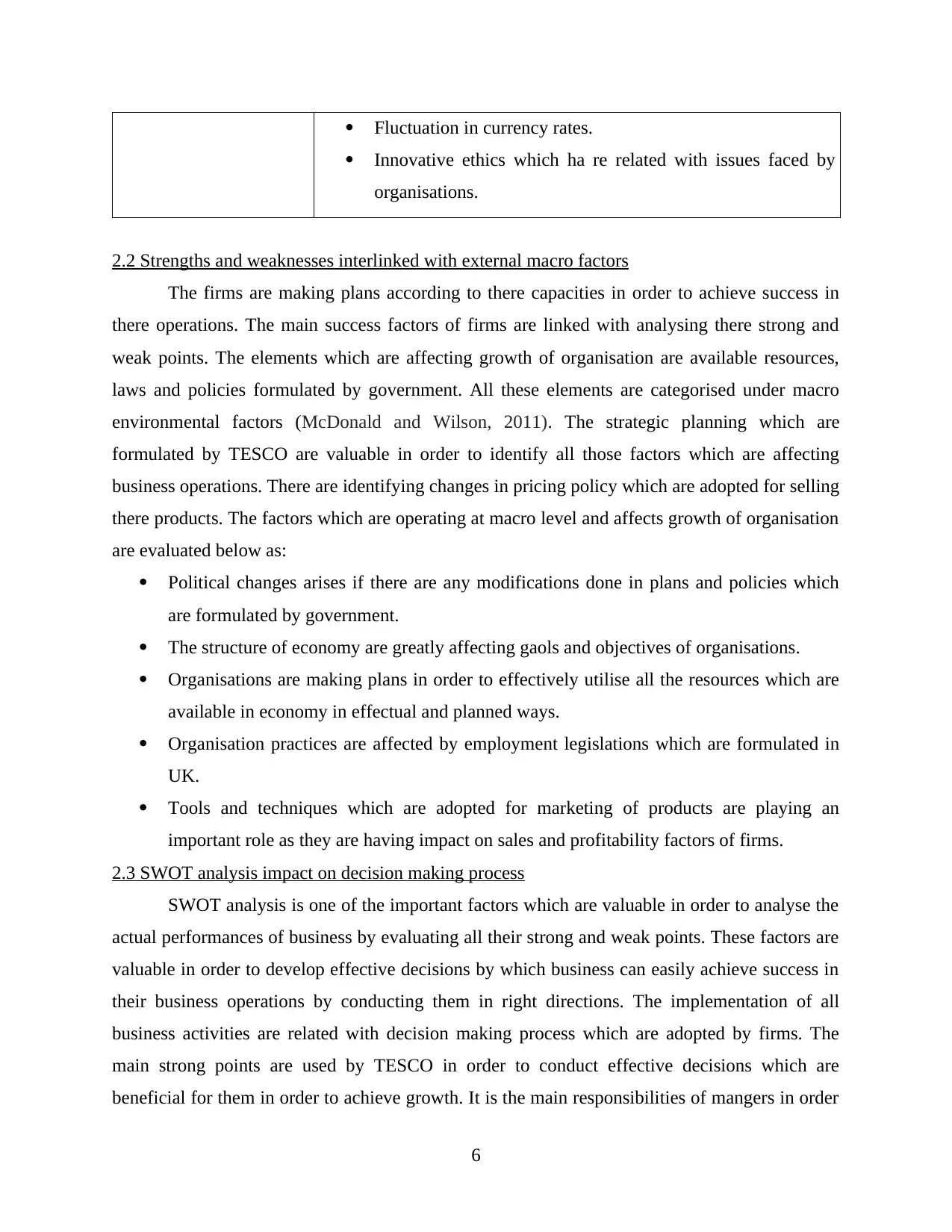
Fluctuation in currency rates.
Innovative ethics which ha re related with issues faced by
organisations.
2.2 Strengths and weaknesses interlinked with external macro factors
The firms are making plans according to there capacities in order to achieve success in
there operations. The main success factors of firms are linked with analysing there strong and
weak points. The elements which are affecting growth of organisation are available resources,
laws and policies formulated by government. All these elements are categorised under macro
environmental factors (McDonald and Wilson, 2011). The strategic planning which are
formulated by TESCO are valuable in order to identify all those factors which are affecting
business operations. There are identifying changes in pricing policy which are adopted for selling
there products. The factors which are operating at macro level and affects growth of organisation
are evaluated below as:
Political changes arises if there are any modifications done in plans and policies which
are formulated by government.
The structure of economy are greatly affecting gaols and objectives of organisations.
Organisations are making plans in order to effectively utilise all the resources which are
available in economy in effectual and planned ways.
Organisation practices are affected by employment legislations which are formulated in
UK.
Tools and techniques which are adopted for marketing of products are playing an
important role as they are having impact on sales and profitability factors of firms.
2.3 SWOT analysis impact on decision making process
SWOT analysis is one of the important factors which are valuable in order to analyse the
actual performances of business by evaluating all their strong and weak points. These factors are
valuable in order to develop effective decisions by which business can easily achieve success in
their business operations by conducting them in right directions. The implementation of all
business activities are related with decision making process which are adopted by firms. The
main strong points are used by TESCO in order to conduct effective decisions which are
beneficial for them in order to achieve growth. It is the main responsibilities of mangers in order
6
Innovative ethics which ha re related with issues faced by
organisations.
2.2 Strengths and weaknesses interlinked with external macro factors
The firms are making plans according to there capacities in order to achieve success in
there operations. The main success factors of firms are linked with analysing there strong and
weak points. The elements which are affecting growth of organisation are available resources,
laws and policies formulated by government. All these elements are categorised under macro
environmental factors (McDonald and Wilson, 2011). The strategic planning which are
formulated by TESCO are valuable in order to identify all those factors which are affecting
business operations. There are identifying changes in pricing policy which are adopted for selling
there products. The factors which are operating at macro level and affects growth of organisation
are evaluated below as:
Political changes arises if there are any modifications done in plans and policies which
are formulated by government.
The structure of economy are greatly affecting gaols and objectives of organisations.
Organisations are making plans in order to effectively utilise all the resources which are
available in economy in effectual and planned ways.
Organisation practices are affected by employment legislations which are formulated in
UK.
Tools and techniques which are adopted for marketing of products are playing an
important role as they are having impact on sales and profitability factors of firms.
2.3 SWOT analysis impact on decision making process
SWOT analysis is one of the important factors which are valuable in order to analyse the
actual performances of business by evaluating all their strong and weak points. These factors are
valuable in order to develop effective decisions by which business can easily achieve success in
their business operations by conducting them in right directions. The implementation of all
business activities are related with decision making process which are adopted by firms. The
main strong points are used by TESCO in order to conduct effective decisions which are
beneficial for them in order to achieve growth. It is the main responsibilities of mangers in order
6
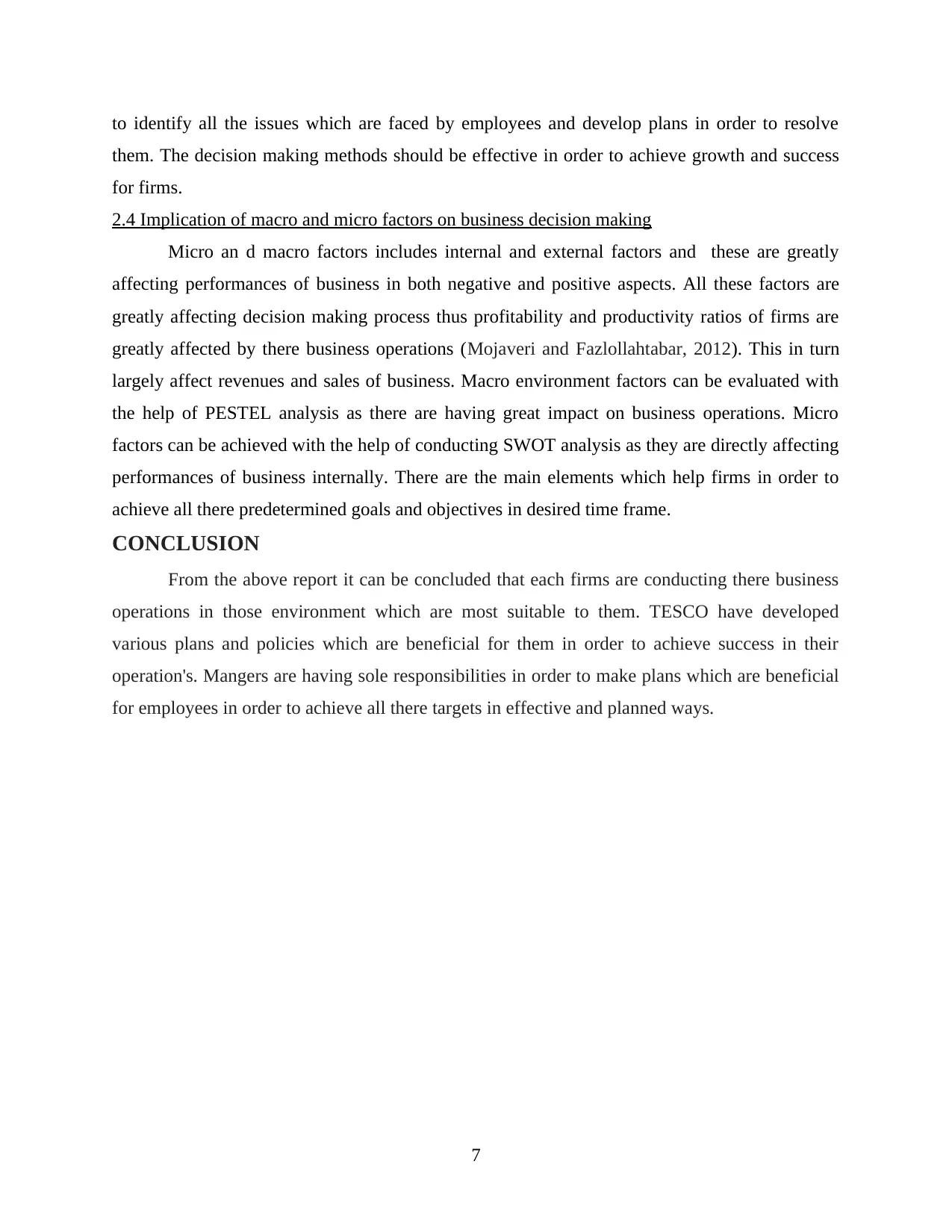
to identify all the issues which are faced by employees and develop plans in order to resolve
them. The decision making methods should be effective in order to achieve growth and success
for firms.
2.4 Implication of macro and micro factors on business decision making
Micro an d macro factors includes internal and external factors and these are greatly
affecting performances of business in both negative and positive aspects. All these factors are
greatly affecting decision making process thus profitability and productivity ratios of firms are
greatly affected by there business operations (Mojaveri and Fazlollahtabar, 2012). This in turn
largely affect revenues and sales of business. Macro environment factors can be evaluated with
the help of PESTEL analysis as there are having great impact on business operations. Micro
factors can be achieved with the help of conducting SWOT analysis as they are directly affecting
performances of business internally. There are the main elements which help firms in order to
achieve all there predetermined goals and objectives in desired time frame.
CONCLUSION
From the above report it can be concluded that each firms are conducting there business
operations in those environment which are most suitable to them. TESCO have developed
various plans and policies which are beneficial for them in order to achieve success in their
operation's. Mangers are having sole responsibilities in order to make plans which are beneficial
for employees in order to achieve all there targets in effective and planned ways.
7
them. The decision making methods should be effective in order to achieve growth and success
for firms.
2.4 Implication of macro and micro factors on business decision making
Micro an d macro factors includes internal and external factors and these are greatly
affecting performances of business in both negative and positive aspects. All these factors are
greatly affecting decision making process thus profitability and productivity ratios of firms are
greatly affected by there business operations (Mojaveri and Fazlollahtabar, 2012). This in turn
largely affect revenues and sales of business. Macro environment factors can be evaluated with
the help of PESTEL analysis as there are having great impact on business operations. Micro
factors can be achieved with the help of conducting SWOT analysis as they are directly affecting
performances of business internally. There are the main elements which help firms in order to
achieve all there predetermined goals and objectives in desired time frame.
CONCLUSION
From the above report it can be concluded that each firms are conducting there business
operations in those environment which are most suitable to them. TESCO have developed
various plans and policies which are beneficial for them in order to achieve success in their
operation's. Mangers are having sole responsibilities in order to make plans which are beneficial
for employees in order to achieve all there targets in effective and planned ways.
7
⊘ This is a preview!⊘
Do you want full access?
Subscribe today to unlock all pages.

Trusted by 1+ million students worldwide

REFERENCES
Books and Journals
Baraya, A. R., Budden, M. C. and Escobar, L. M., 2011. Strategically Enhancing Business
Capabilities And Social Development In The Hispanic Community. Journal of Business
& Economics Research (JBER). 6(6).
Chavis, L. W., Klapper, L. F. and Love, I., 2011. The impact of the business environment on
young firm financing. The world bank economic review. 25(3). pp.486-507.
Eckardt, M., 2012. The European Private Company: Do we need another 28th private company
law form in the EU? On regulatory competition of corporate law.
Eisenberg, T. and Miller, G. P., 2012. The English versus the American rule on attorney fees: an
empirical study of public company contracts. Cornell L. Rev.. 98. p.327.
George, G. and Bock, A. J., 2011. The business model in practice and its implications for
entrepreneurship research. Entrepreneurship theory and practice. 35(1). pp.83-111.
Hamilton, L. and Webster, P., 2015. The international business environment. Oxford University
Press, USA.
McDonald, M. and Wilson, H., 2011. Marketing plans: How to prepare them, how to use them.
John Wiley & Sons.
Mojaveri, H. S. and Fazlollahtabar, H., 2012. Designing an integrated AHP based fuzzy expert
system and SWOT Analysis to prioritize development strategies of Iran agriculture.
Revista de Management Comparat International. 13(1). p.117.
Myers, M. and Korsmo, C., 2014. Appraisal Arbitrage and the Future of Public Company M&A.
Online
SWOT Analysis. 2017. [Online]. Available through:
<https://www.mindtools.com/pages/article/newTMC_05.htm>.
8
Books and Journals
Baraya, A. R., Budden, M. C. and Escobar, L. M., 2011. Strategically Enhancing Business
Capabilities And Social Development In The Hispanic Community. Journal of Business
& Economics Research (JBER). 6(6).
Chavis, L. W., Klapper, L. F. and Love, I., 2011. The impact of the business environment on
young firm financing. The world bank economic review. 25(3). pp.486-507.
Eckardt, M., 2012. The European Private Company: Do we need another 28th private company
law form in the EU? On regulatory competition of corporate law.
Eisenberg, T. and Miller, G. P., 2012. The English versus the American rule on attorney fees: an
empirical study of public company contracts. Cornell L. Rev.. 98. p.327.
George, G. and Bock, A. J., 2011. The business model in practice and its implications for
entrepreneurship research. Entrepreneurship theory and practice. 35(1). pp.83-111.
Hamilton, L. and Webster, P., 2015. The international business environment. Oxford University
Press, USA.
McDonald, M. and Wilson, H., 2011. Marketing plans: How to prepare them, how to use them.
John Wiley & Sons.
Mojaveri, H. S. and Fazlollahtabar, H., 2012. Designing an integrated AHP based fuzzy expert
system and SWOT Analysis to prioritize development strategies of Iran agriculture.
Revista de Management Comparat International. 13(1). p.117.
Myers, M. and Korsmo, C., 2014. Appraisal Arbitrage and the Future of Public Company M&A.
Online
SWOT Analysis. 2017. [Online]. Available through:
<https://www.mindtools.com/pages/article/newTMC_05.htm>.
8
1 out of 10
Related Documents
Your All-in-One AI-Powered Toolkit for Academic Success.
+13062052269
info@desklib.com
Available 24*7 on WhatsApp / Email
![[object Object]](/_next/static/media/star-bottom.7253800d.svg)
Unlock your academic potential
Copyright © 2020–2025 A2Z Services. All Rights Reserved. Developed and managed by ZUCOL.





